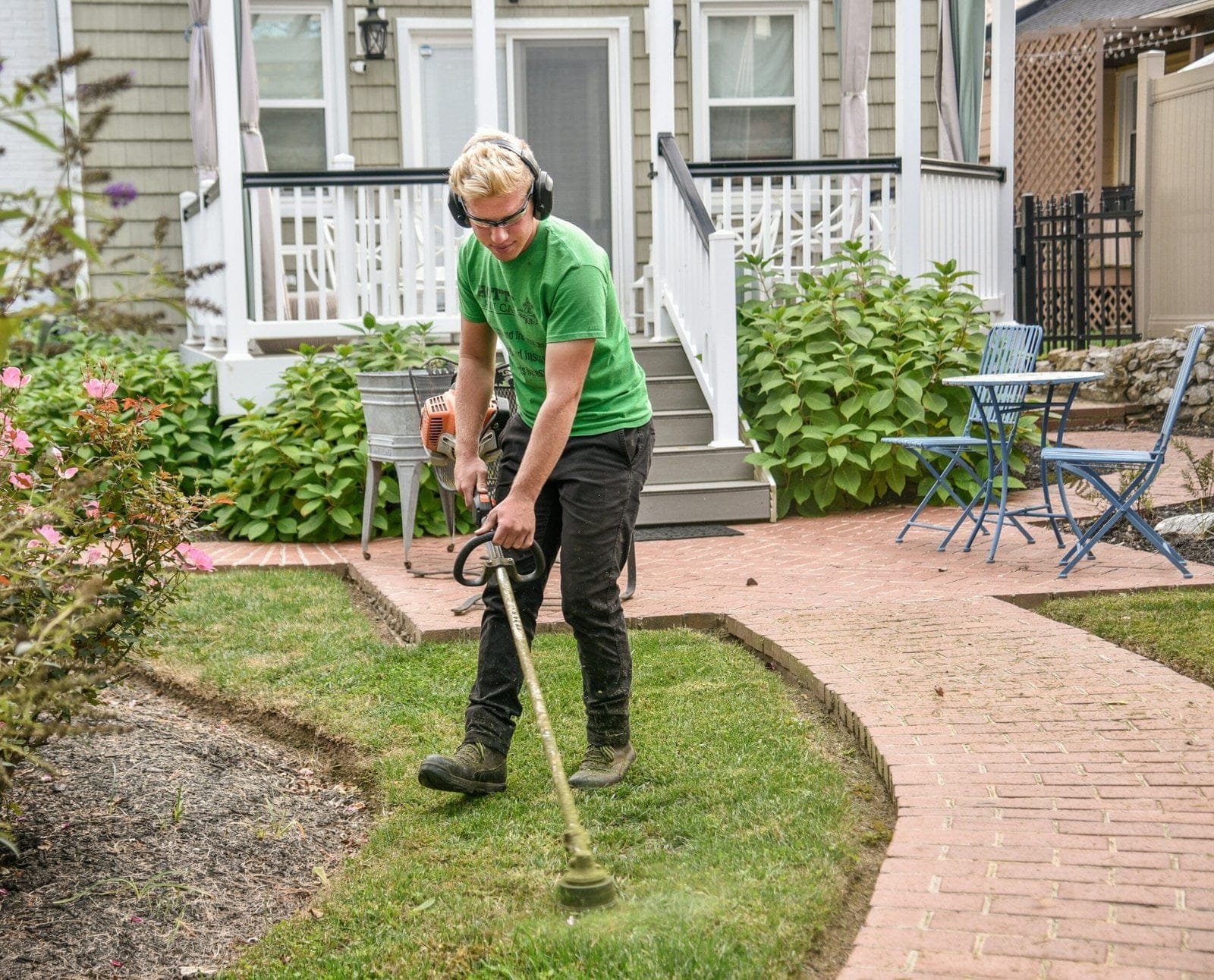Learn the essential steps for maintaining a lush and healthy lawn, including soil preparation, choosing the right grass type, proper mowing techniques, efficient watering practices, fertilization strategies, and effective weed and pest control methods. Follow our seasonal lawn care tips to ensure your yard thrives year-round.
The Importance of Soil Preparation
Before you begin planting grass seeds or laying sod, it is crucial to prepare your soil properly to ensure a healthy and lush lawn. One of the first steps in soil preparation is testing the soil pH. Grass thrives best in soil with a pH level between 6.0 and 7.0, which is considered slightly acidic to neutral. Testing kits are readily available and simple to use. If your soil pH is outside this range, you can amend it with lime to raise the pH or sulfur to lower it. Adjusting the pH to an optimal level is essential, as it influences the grass’s ability to absorb nutrients effectively.

Another critical aspect of soil preparation is aeration. Over time, soil can become compacted, which restricts root growth and limits the grass’s access to water and nutrients. Aerating the soil involves perforating the ground with small holes to allow air, water, and nutrients to penetrate the roots. This process not only alleviates soil compaction but also promotes stronger root development, leading to a more resilient and greener lawn.
Please, read our post and do not forget to check our YouTube channel “Grig Stamate”:
https://www.youtube.com/@GrigStamate
You will find there, thousands of designing, furnishing, and decorating ideas for your home interior and outdoors.
Allow me to mention one of them:
Beautiful Gardens and Flower Gardens | OUTDOOR DECOR & LANDSCAPING IDEAS #12 (video)
In addition to pH adjustment and aeration, incorporating organic matter into the soil is vital. Adding compost or other organic materials can significantly enhance soil structure and fertility. Organic matter improves water retention, drainage, and nutrient availability. It also supports a healthy population of soil organisms, which play a crucial role in breaking down organic material and releasing nutrients. By enriching the soil with compost, you create a favorable environment for grass to establish and flourish.
Effective soil preparation sets the foundation for a thriving lawn. Ensuring the soil pH is within the optimal range, relieving compaction through aeration, and adding organic matter are key steps that contribute to robust root systems and vibrant, healthy grass. Taking the time to prepare your soil properly will pay off in the long run, resulting in a greener and more beautiful yard.
Choosing the Right Grass Type
One of the foundational steps to achieving a greener, healthier lawn is selecting the appropriate grass species that aligns with your specific climate, soil type, and lawn usage. The choice between cool-season and warm-season grasses plays a critical role in the long-term success of your yard.
Cool-season grasses, such as Kentucky bluegrass and fescue, thrive in regions with cooler temperatures. Kentucky bluegrass is renowned for its rich, dark green color and fine texture. However, it requires a significant amount of water and can be susceptible to diseases in high humidity. Fescue, on the other hand, is slightly more drought-tolerant and can withstand a wider range of soil conditions. Nevertheless, it may not exhibit the same lushness as Kentucky bluegrass during peak growing seasons.
Warm-season grasses, like Bermuda and Zoysia, flourish in warmer climates. Bermuda grass is highly durable, making it an ideal choice for high-traffic areas. It has excellent heat and drought tolerance but can be invasive, spreading quickly and potentially overtaking other plants. Zoysia grass is also robust, offering a dense, carpet-like texture and strong resistance to disease. However, it can be slow to establish and may require more intensive maintenance during the growing season.
When selecting the right grass type, it’s essential to consider the amount of sun exposure and shade your lawn receives. Most grass species require ample sunlight to thrive, but some, like fine fescue and certain varieties of Zoysia, can tolerate partial shade. Evaluating these factors will help you choose a grass type that maximizes the aesthetic and functional benefits of your yard.
By carefully selecting a grass species that matches your local climate, soil conditions, and lawn utilization, you set the stage for a vibrant and resilient lawn. Understanding the unique characteristics and requirements of each grass type ensures your efforts in lawn care yield the lush, green results you desire.
Proper Mowing Techniques
Maintaining a lush and healthy lawn requires attention to proper mowing practices. One of the key aspects is understanding the ideal mowing height for different grass types. For instance, cool-season grasses like Kentucky bluegrass and fescue thrive when kept between 2.5 and 3.5 inches tall, while warm-season grasses such as Bermuda and zoysia benefit from a height of 1 to 2 inches. Adhering to these recommended heights helps ensure that your lawn remains dense and resilient against weeds and diseases.
Equally important is the sharpness of your mower blades. Dull blades can tear grass, leaving jagged edges that not only look unsightly but also make the grass more vulnerable to diseases and pests. Regularly sharpening your mower blades will result in cleaner cuts, promoting quicker recovery and healthier lawn growth.
Timing your mowing sessions is another crucial factor. Mowing during the cooler parts of the day, such as early morning or late afternoon, minimizes stress on the grass. This practice helps retain moisture and prevents the lawn from wilting under the midday sun. Additionally, alternating the mowing direction each time encourages even growth and prevents the grass from leaning in one direction.
Finally, consider leaving grass clippings on the lawn after mowing. These clippings act as a natural fertilizer, returning essential nutrients such as nitrogen, phosphorus, and potassium back into the soil. This practice, known as grasscycling, can significantly reduce the need for additional fertilizers and contribute to the overall health and greenness of your lawn.
By incorporating these proper mowing techniques, you will be well on your way to achieving a greener, more vibrant lawn that not only enhances the beauty of your yard but also supports a healthier ecosystem.
Efficient Watering Practices
Achieving a greener lawn hinges significantly on efficient watering practices. One of the fundamental principles to follow is deep and infrequent watering. Unlike frequent, shallow watering, which encourages roots to remain near the surface, deep watering ensures that moisture penetrates the soil thoroughly. This practice promotes deeper root growth, making your lawn more resilient to drought and varying weather conditions.
Typically, lawns need about 1 inch of water per week. This amount can be delivered through a combination of rainfall and manual watering. To measure this accurately, homeowners can utilize rain gauges, which help track the amount of natural precipitation. Overwatering can be just as detrimental as underwatering, so monitoring is crucial. Soil moisture sensors can also be employed to provide real-time data on the soil’s moisture levels, ensuring that your lawn receives the optimal amount of water without wastage.
Timing is another critical factor in an effective watering regimen. Watering early in the morning, preferably before 10 a.m., is highly recommended. During these hours, temperatures are cooler, and winds are generally calmer, leading to reduced evaporation. This ensures that more water reaches the roots rather than being lost to the atmosphere. Additionally, watering in the morning allows the grass blades to dry out during the day, reducing the risk of fungal diseases that thrive in damp conditions.
Incorporating these efficient watering practices not only fosters a lush and healthy lawn but also conserves water, contributing to a more sustainable environment. By understanding and implementing these guidelines, you can achieve a greener lawn that is both aesthetically pleasing and ecologically responsible.
Fertilization Strategies
Proper fertilization is essential for maintaining a green, healthy lawn. Fertilizers provide the necessary nutrients that grass needs to thrive. There are two main types of fertilizers: synthetic and organic. Each has its pros and cons, and choosing the right type depends on your lawn’s specific needs and your environmental considerations.
Synthetic fertilizers are chemically manufactured and offer immediate availability of nutrients. One of the advantages of synthetic fertilizers is their fast action; they can quickly green up a lawn and promote rapid growth. However, they can also lead to nutrient runoff, which may harm local waterways and the environment if not applied correctly.
On the other hand, organic fertilizers are derived from natural sources such as compost, manure, and bone meal. These fertilizers release nutrients slowly, providing a steady supply of nourishment to the lawn over time. Organic fertilizers improve soil structure and increase microbial activity, which benefits the overall health of the lawn. The downside is that they generally act more slowly than synthetic options and may be less concentrated, requiring larger application amounts.
A basic fertilization schedule is crucial for achieving a lush lawn. Start in early spring, when the grass begins to green up, with a balanced fertilizer to encourage new growth. In late spring, use a fertilizer with higher nitrogen content to promote strong, green blades. During the summer, a light feeding with a slow-release fertilizer can help maintain the lawn’s health without causing stress. Finally, in the fall, apply a fertilizer rich in potassium to strengthen the grass and prepare it for winter dormancy.
It is vital to follow recommended application rates to avoid over-fertilization. Over-fertilizing can lead to excessive growth, increased thatch, and even lawn burn, where the grass turns brown and dies. Additionally, over-fertilization can contribute to nutrient runoff, posing environmental risks. Always read and adhere to the instructions on the fertilizer package to ensure your lawn receives the appropriate amount of nutrients.
Weed Control Methods
Maintaining a lush and healthy yard involves effective weed control methods, which are essential for preventing unwanted plants from competing with your grass for nutrients, water, and sunlight. One of the most effective strategies for controlling weeds is the use of pre-emergent herbicides. These herbicides work by creating a chemical barrier that prevents weed seeds from germinating. Applying a pre-emergent herbicide in early spring can significantly reduce the number of weeds that sprout during the growing season.
For dealing with existing weeds, post-emergent herbicides are the go-to solution. These herbicides are designed to target and kill weeds that have already germinated and are growing in your lawn. When using post-emergent herbicides, it is important to follow the product instructions carefully to ensure maximum effectiveness and to avoid damaging your grass.
In addition to chemical treatments, maintaining a thick, healthy lawn is crucial for natural weed control. A dense lawn can crowd out weeds by limiting the space and resources available for their growth. Regular mowing, proper fertilization, and adequate watering are key practices that promote a robust lawn, which in turn helps to suppress weed growth.
Manual weeding is another effective method for controlling weeds, especially for smaller lawns or for weeds that are resistant to herbicides. Hand-pulling weeds, using a weeding tool, or hoeing can be time-consuming but provides immediate results and can be particularly useful in areas where chemical use is not desirable.
For those seeking natural weed control methods, household items like vinegar solutions can be effective. A solution of vinegar, water, and dish soap can be sprayed directly onto weeds to kill them. Corn gluten meal is another natural option, working as a pre-emergent herbicide that prevents weed seeds from germinating. It also adds nitrogen to the soil, which benefits your lawn.
Incorporating a combination of these weed control methods can help you achieve a greener lawn, free from the competition of invasive weed species. By using a mix of chemical, manual, and natural approaches, you can maintain a healthy yard that thrives throughout the growing season.
Pest and Disease Management
Maintaining a lush and healthy lawn involves vigilant pest and disease management. Common lawn pests, such as grubs, chinch bugs, and sod webworms, can cause significant damage if left unchecked. Grubs, for instance, feed on grassroots, leading to brown, wilting patches that can be easily lifted from the soil. Chinch bugs suck sap from grass blades, creating yellow, drought-like spots. Sod webworms chew grass blades, leaving behind irregular brown patches. Recognizing these signs early is crucial for effective pest control.
In addition to pests, various lawn diseases can also jeopardize lawn health. Fungal diseases such as brown patch, dollar spot, and powdery mildew manifest through distinct symptoms. Brown patch creates circular brown areas, dollar spot leaves silver-dollar-sized lesions, and powdery mildew covers grass with a white, powdery substance. Identifying these symptoms promptly allows for timely and appropriate interventions.
Integrated Pest Management (IPM) is a sustainable approach that combines biological, cultural, and chemical methods to control pests with minimal environmental impact. Biological controls include introducing natural predators like nematodes to manage grubs. Cultural practices involve maintaining proper lawn health through regular mowing, aeration, and dethatching, which can reduce pest habitats. Chemical controls should be used judiciously, selecting targeted pesticides that minimize harm to beneficial organisms.
Preventative measures are paramount in naturally resisting pests and diseases. Proper mowing height, usually around 2.5 to 3.5 inches, ensures a dense, healthy lawn that can outcompete weeds and withstand pest attacks. Regular watering, ideally in the early morning, promotes deep root growth and reduces disease risks. Fertilization with balanced nutrients tailored to your grass type strengthens the lawn’s resilience against pests and diseases.
Implementing these strategies not only helps in managing current pest and disease issues but also fortifies your lawn’s defenses against future threats. By adopting a holistic approach, you can maintain a greener, healthier lawn with reduced reliance on chemical interventions, contributing positively to the environment.
Seasonal Lawn Care Tips
Maintaining a lush and healthy yard requires a strategic approach to lawn care, tailored to the changing seasons. By adjusting your practices throughout the year, you can ensure your lawn remains vibrant and resilient. Here is a seasonal breakdown to guide you through the essential tasks:
Spring
Spring is the time to rejuvenate your lawn after the dormant winter months. Begin by testing your soil to determine its pH and nutrient levels. This will guide any necessary amendments to create the ideal growing environment. Aeration is crucial during this period, as it alleviates soil compaction and enhances water and nutrient absorption. Follow aeration with overseeding to address bare patches and improve overall grass density.
Summer
As temperatures rise, consistent watering becomes paramount. Aim to water deeply and less frequently to encourage deep root growth. Early morning is the best time to water to minimize evaporation. Mowing practices also need adjustment; keep your grass a bit taller to provide shade to the roots and reduce water loss. Regular mowing with sharp blades will help maintain a healthy lawn and prevent disease.
Fall
Fall is the season to fortify your lawn in preparation for winter. Fertilization during this period helps grass recover from summer stress and build up reserves for the colder months. Use a high-phosphorus fertilizer to promote strong root growth. Weed control is also essential; tackle perennial weeds before they go dormant. Finally, consider overseeding again to thicken your lawn and enhance its resilience.
Winter
During winter, the focus is on protecting your lawn from harsh conditions. Minimize foot traffic to prevent soil compaction and damage to the grass. Avoid using harsh de-icing chemicals, as these can be detrimental to your lawn’s health. Instead, opt for sand or kitty litter to provide traction without harming your grass.
By tailoring your lawn care practices to each season, you can foster a greener, healthier yard that thrives year-round. Always consider the specific needs of your lawn and local climate to optimize your efforts.
Other related posts from our website:
https://howtobuildahouseblog.com/creating-a-wildlife-friendly-and-sustainable-lawn/
Thank you so much for your attention.
Stay tuned. We will upload many other amazing posts to our website and videos onto our YouTube channel.
Thank you so much.
for your time and attention.
Best Regards
See you to another post,
Bye, Bye


